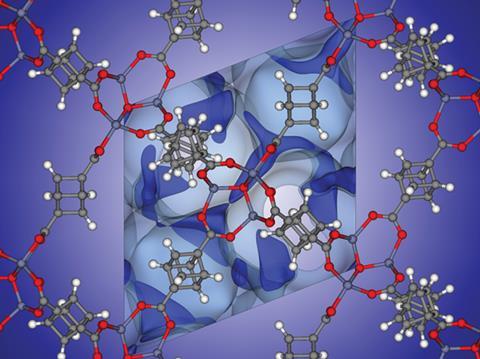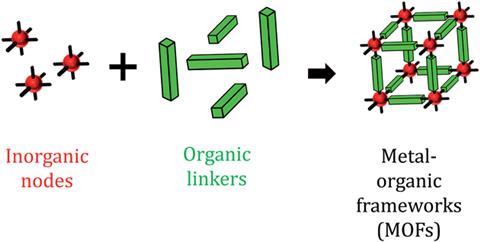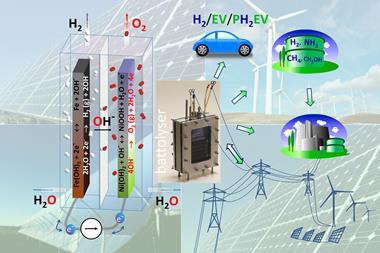Identifying performance limits for nanoporous materials highlights that current methane storage goals might be unrealistic

Is it possible to design a material to fulfil current methane storage goals? This is the question that a multi-disciplinary research team set out to answer by rapidly screening hundreds of thousands of possible methane storage materials in a computational study. Methane could reduce global dependence on oil so the search is on for nanoporous materials to act as fuel tanks for this tricky-to-store gas; but things are not looking promising.
‘Natural gas storage in porous materials provides the key advantage of being able to store significant natural gas at low pressures than compressed gas at the same conditions,’ explains engineer Mike Veenstra of Ford Motor Company, US, who was not involved in the research. ‘The advantage of low pressure is the benefit it provides both on-board the vehicle and off-board at the station. On the vehicle, low pressure reduces the tank attributes along with the other components. At the station, low pressure reduces the compressor stages along with the attributes of other components.’
Randall Snurr at Northwestern University, US, Berend Smit at the University of California, Berkeley, US, and their colleagues around the globe are part of the Materials Genome Initiative that intends to revolutionise materials chemistry in the same way the Human Genome Project did for the biological sciences. They have developed a computer algorithm that simulates model structures, and identifies their pore sizes in relation to deliverable methane storage capacity, based on the current idea of what it is possible to make. The simulations are particularly useful for metal–organic frameworks (MOFs), and considering the vast combinations of inorganic and organic molecular building blocks available, few have been synthesised and tested. ‘Experimentalists have synthesised somewhere between 5000 and 10,000 MOFs and less than 250 zeolite structures over several decades. In this computational study, we examined over 650,000 such structures in a much shorter time,’ explains Snurr.

The best experimentally measured capacity of any material falls short of the current US Advanced Research Project Agency-Energy (ARPA-E) methane storage target. Smit says the conventional approach is to rely on experiments to answer questions as to whether the target is feasible or not: ‘Here we make a bold statement: the current approach is not going to get us there.’ Instead, he says that using calculations to rapidly determine relevant methane storage candidates saves valuable time and resources.
Here we make a bold statement: the current approach is not going to get us there
Calculations reveal an optimal pore diameter of around 11Å for methane storage; any larger and the van der Waals interactions between the gas molecules and the pore walls cannot be felt. The ideal material also has a high density of adsorption sites to optimise methane interactions. Comparing the calculated structures against current goals, the researchers quickly established that it may be impossible to reach the desired target using such materials. With a computational infrastructure in place, the effect of different temperatures and pressures on the structures can be readily recalculated, showing how these factors impact on the deliverable methane capacity. However, even by adopting more favourable parameters, no materials were able to reach the ARPA-E target. From the large number of structures examined computationally, the highest predicted deliverable capacity echoes those observed for the current top sorbent materials, meaning that these materials may already be at their limit.
Joe Zhou, an expert in materials at Texas A&M University, US says ‘research in materials science depends on theoretical simulation to set the boundary, guide the synthesis, and eventually confirm the experimental results.’ He says that for methane storage, understanding what is achievable in industry is critical. ‘Generally speaking, theoretical work focusing on enumerating possible materials is common, but to explore the performance limits is a definite step toward guiding the invention of novel materials.’
MOFs and related materials are not only useful for methane storage. The huge amount of computational data from this study can now be data mined to identify their performance in alternative applications. Similar materials genome-style screening studies could be carried out to identify what is realistically possible to achieve in other areas, including lithium-ion batteries and photovoltaics. Smit says, ‘I am fascinated by the insights these screening studies give; normally one can say something about a few materials – now we have insights on the performance of an entire class of materials. This has completely changed my view on how to do materials research.’
References
This article is free to access until 26 March 2015. Download it here:
C M Simon et al, Energy Environ. Sci., 2015, DOI: 10.1039/c4ee03515a












No comments yet